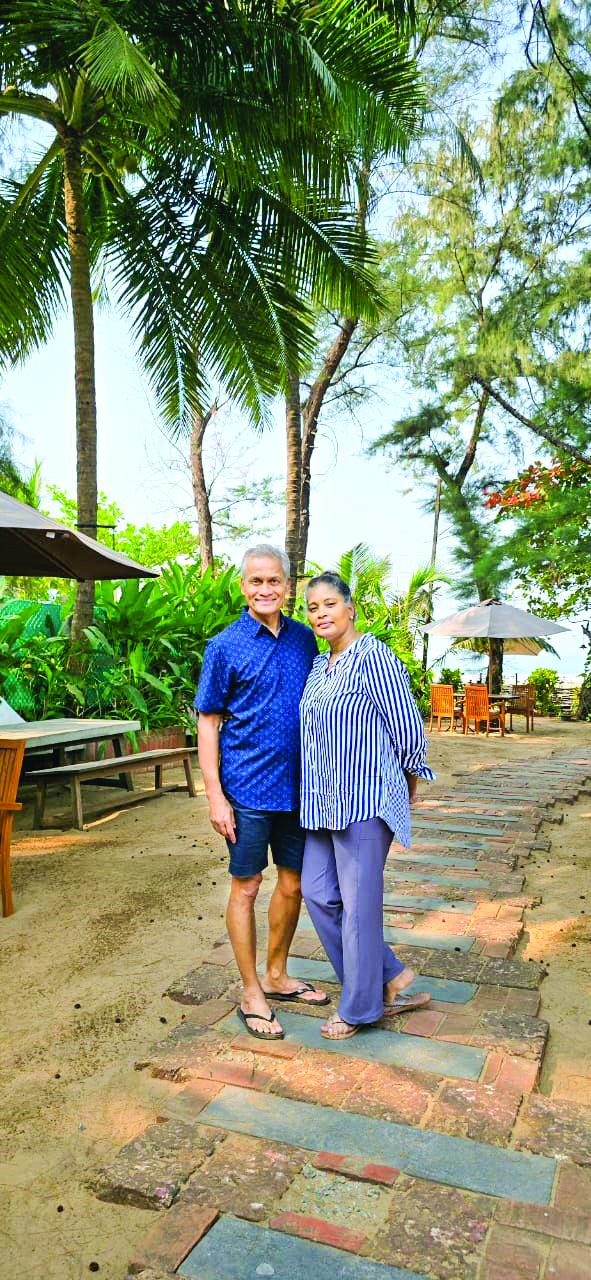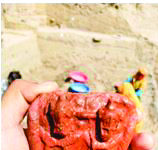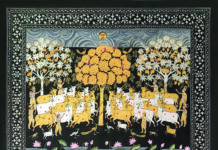Almost by chance, I found myself at the very end of Nirvana Beach in Kumta. A discreet sign showed my destination – the Panchabhuta Conservation Foundation, run by Mangal and Ambika Shetty. I had planned to return to Bengaluru after an overnight trip to Udupi when my son, who was heading to Goa for an open water swim practice, suggested I go visit Panchabhuta. I was swayed by Mangal’s frequent posts on social media.
Here’s a sample where he described stunning sedimentary rockscapes: “The intricate layered patterns, chiselled & compacted by the oceans, winds and the monsoons over thousands of years… the stunning contours, colours, textures, strata, and their sheer magnificence! All this beauty set against the sounds of the waves! Nature reveals its very best in those fleeting moments. I wonder what it will be like at sunset and low tides.” Setting out to find out for myself, I discovered a slice of heaven – the azure waves of the Arabian Sea lapping at my feet on the soft sands of a secluded and serene cove, delicious, finely presented food and a luxurious eco-cottage.
Mangal had returned to these shores in 2012 after selling his tech company in New York, responding to a deeper calling. The Panchabhuta Conservation Foundation emerged from this homecoming, its headquarters nestled where I now stood. Surrounded by the breathtaking Aghanashini estuary, the ecosystem comprises a thriving undammed river, lush mangroves and vibrant birdlife. The Foundation was set up to drive sustainable development and livelihood while ensuring the health of the estuary and its inhabitants and fostering biodiversity. Mangal worked hard to get it recognised as a Ramsar site, a ‘Wetland of International Importance’. The increased global recognition puts the Aghanashini’s unique beauty and significance on the map and attracts international support. It also safeguards this ecology from future threats and ensures its sustainability.
The inspiration can be traced back to the verdant hills of the Malnad area near Sringeri, where, as a young boy, Mangal learned to become part of nature itself. His father, a plantation doctor inspired by the Independence movement, moved to serve rural India. His four sons learned that nothing could match the joy of being in the deepest of nature, whether forest, water or estuary, at their maternal grandparents’ home near the Netravathy River. “This is how I got wired”, Mangal told me.
A fortuitous opening led him to India’s first batch of Master’s in Computer Applications, and he started his own company, developed revolutionary stock exchange software, and set up an office at 140 Broadway, just opposite the World Trade Center. Then came September 11th, 2001. That single event, Mangal reflected, broke more than just buildings. In the aftermath of that terrible day, he began to think about an exit strategy – not just from his company, but toward something that called to his heart while he was still young.
The successful sale of his company in 2004-2005 gave him peace and the luxury of introspection. “I could go back to myself and think through what I really want to do in life,” he explained. Everything pointed back to nature, back to that childhood wiring that had never been fully severed. And so began the search for “pieces of nature” that could become his canvas. From Karwar to Mangaluru, he sought extraordinary landscapes along the coast and in the Western Ghats. He recalled the day he arrived here, at this confluence of the Aghanashini estuary and the Arabian Sea, “I had goosebumps when I came here. I knew this was the place.”
But transforming vision into reality proved far more complex than software development. Suddenly, he was navigating “a complex tapestry of title, of community, of governance and corruption and provisions.” What he thought would take ten years became a lifetime commitment to community building and ecological restoration. It also led to a shift in perspective. “This is a journey and not a destination,” Mangal said, and I could sense the peace that this realisation had brought him. The Foundation became his way of integrating with the community, of creating what he calls a “responsible natural economy” – a constellation of wellness ventures that would bring mental, physical, and spiritual healing while protecting and regenerating the landscape that inspired them.
The Panchabhuta Retreat became the first manifestation of Biogen Wellness, Mangal’s visionary venture dedicated to nurturing nature-conscious enterprises. A network of sustainable experiences across hospitality, real estate, and natural products, all rooted in the wisdom of the natural world.
Mangal has an interesting take on capital – apart from financial capital, he wants to deliver on human capital, social capital and natural capital. There are plans for food ventures, sports retreats, and nature immersion experiences spread across multiple properties, including another piece of untouched land near the Kollur Mookambika temple. He aims to create a destination where people come and experience nature, fall in love with it, want to protect and live their lives in connection with nature. “That’s my goal. It’s not just an eco-tourism resort.”
This vision extends beyond Mangal’s own ventures. Throughout the wetlands and mangroves, across fourteen or fifteen villages housing 64,000 people, he envisions a network of community entrepreneurs – homestay operators, boat fleet owners, food producers – all connected through revenue-sharing models that make responsible tourism truly integrated with local prosperity. The ambition is to create a supply chain of four or five hundred entrepreneurs who can be independently successful in their businesses. Women are going to be an important part of this, said Mangal, as in Uttara Kannada, women have demonstrated better entrepreneurial capability than men. Ambika has created a natural skincare brand using locally sourced kokum and has been leading training workshops in the creation of these products to empower local women. It’s being spun off into a separate venture with over a dozen products, and having tried some of them, I vouch for their efficacy. There are also other new-age approaches to wellness they plan to implement, but that’s a story for another column.
– Sandhya Mendonca, author, biographer, and publisher at Raintree Media, offers a distinct female gaze of the world in this column.








